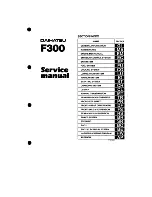
2nd re-issue
Page 4
If the level of the electrolyte Is so low that a
hydrometer reading cannot be taken, no
attempt should be made to take a reading after
adding distilled water until the battery has been
on charge for at least thirty minutes.
Note.-lf the car is out of use for any length of
time the battery should not be allowed to run
down or to remain in a discharged condition.
It should be recharged about every fortnight
from an· independent electric supply.
7. Heavy Discharge Test
A heavy discharge tester consists of a centre
zero voltmeter, 2 or 3 volts full scale, across
which is connected a shunt resistance capable
of carrying the current involved. Pointed
prongs are provided for making contact with
the inter-cell connectors.
Pierce the indentations in the battery top with
a heated, pointed tool and press the contact
prongs against the exposed positive and nega
tive terminals of each cell. A good cell will
maintain a reading of 1·2-1·5 volts, depending
on the state of charge, for at least 6 seconds.
If, however, the reading rapidly falls, the cell is
probably faulty and a new plate assembly may
have to be fitted.
Remember that if the battery is subjected to
heavy loads (I.e., long periods of night parking
with lights on) without suitable opportunities
for recharging, a low state of charge is only to
be expected. A fault In the dynamo or regu
lator, or neglect during a period out of com
mission, may also be responsible for any trouble.
RECHARGING FROM AN EXTERNAL
SUPPLY
If tests indicate that the battery is discharged, but
is otherwise in good condition, it should be re
charged, either on the vehicle by a period of daytime
running or on the bench from an external supply.
If the latter, the battery should be charged at 5
amperes until the specific ·gravity and voltage show
no Increase over three successive hourly readings.
During the charge the electrolyte must be kept level
WSM. 124
Section N (Elec. Equip,)
with the tops of the separator guard by the addition
of distilled water. Re-charge rates are as follows:-
BT 7A Batteries (43 ampere-hour) 4 amps.
BV 9-11A Batteries (67 ampere-hour) 6 amps.
Do not allow the temperature of the electrolyte
to exceed the maximum permlssable temperature
during charging. I.e.,
Climates below 80
°
F. (26·7
°
C.)
Climates above 80
°
F. (26·7
°
C.)
100
°
F. (37·8
°
C.)
120
°
F. (48·9
°
C.)
A battery In which all cells show a general falling off
In efficiency will often respond to the process
known as "cycling". This process consists of fully
charging the battery as described above, and then
discharging it by connecting to a lamp board, or
other load, at the same rate. The battery
should be capable of providing this current for at·
least 7 hours before it is fully discharged, as Indi
cated by the voltage of each cell falling to 1 ·8. If
the battery discharges In a shorter time, repeat
the "cycle" of charge and discharge.
PREPARING
SERVICE
NEW
BATTERIES
FOR
Batteries for the home market are normally supplied
dry and uncharged; In this event the Instruction In
para. (a) should be followed.
Batteries for export markets are supplied "dry
charged". Before fitting to the vehicle the battery
must be filled with acid as described in paragraph
(b); no initial charging is necessary, although, If time
permits a short freshening charge is advantageous.
Preparation of Electrolyte
Electrolyte of the specific gravity given below Is
prepared by mixing distilled water and concentrated
sulphuric acid, usually of 1 ·835 S.G. The mixing
must be carried out either In a lead-lined tank or
In suitable glass or earthenware vessels. Slowly
add the acid to the water, stirring with a glass rod.
Never add the water to the acid as the result
ing chemical reaction causes violent and dangerous
spurting of the concentrated acid. The approxi
mate proportions of acid and water are Indicated In
the table.
Summary of Contents for ALPINE I SERIES: APLINE II SERIES
Page 1: ......
Page 189: ...Fis 21 Ball pin heirht checkinr fixture in position Details of items 1 to 4 In Fig 22...
Page 208: ...Fla 3 Exploded view of rear axle Hypoid Bevel Drive...
Page 220: ...Page 16 WSM 12 f Section G Rear Axle 0 QQ I I I I I t 0 ii 8 ts t 0 Cl 2 i J...
Page 247: ...Page6 WSM 124 Section J Steering N Iii it...
Page 299: ...Page 40 3 6 7 8 Fis 22 Se rvo unit exploded view Sect WSM 124 ion K Brakes 18 419 GZo 21...
Page 413: ..._ PRINTED IN ENGLAND 9Y WREN PRINTING CQ LTD LONDON...
















































